Japan Defense Market Size
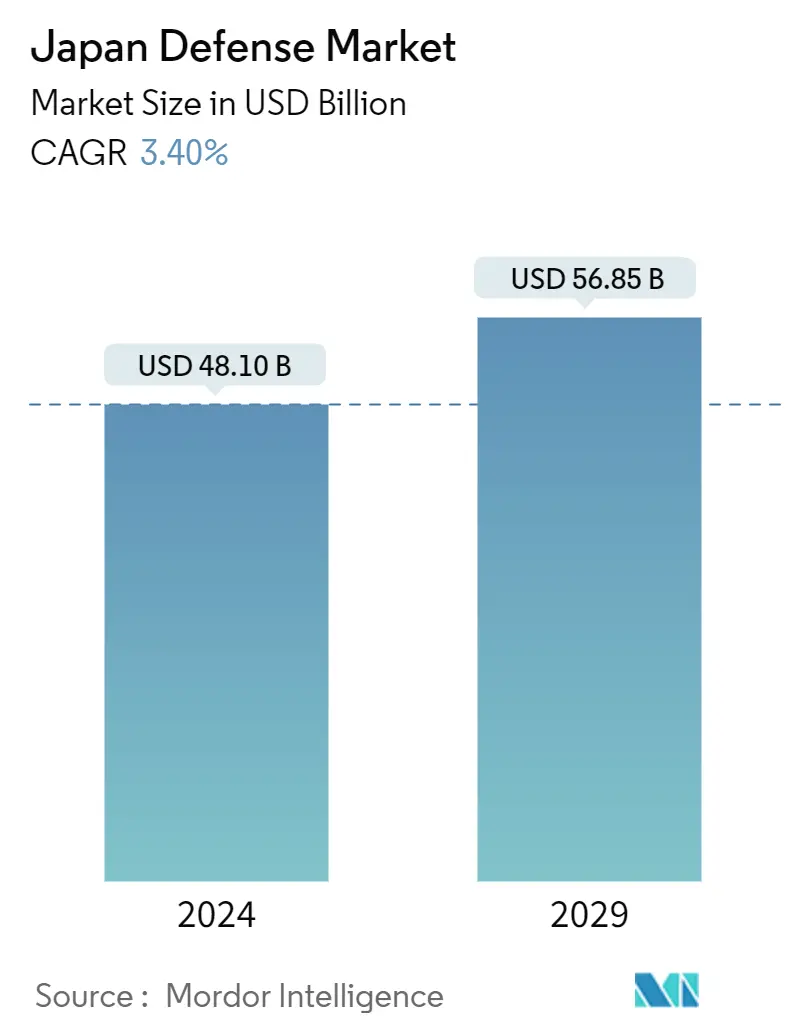
| Study Period | 2019-2029 |
| Base Year For Estimation | 2023 |
| Market Size (2024) | USD 48.10 Billion |
| Market Size (2029) | USD 56.85 Billion |
| CAGR (2024 - 2029) | 3.40 % |
| Market Concentration | Medium |
Major Players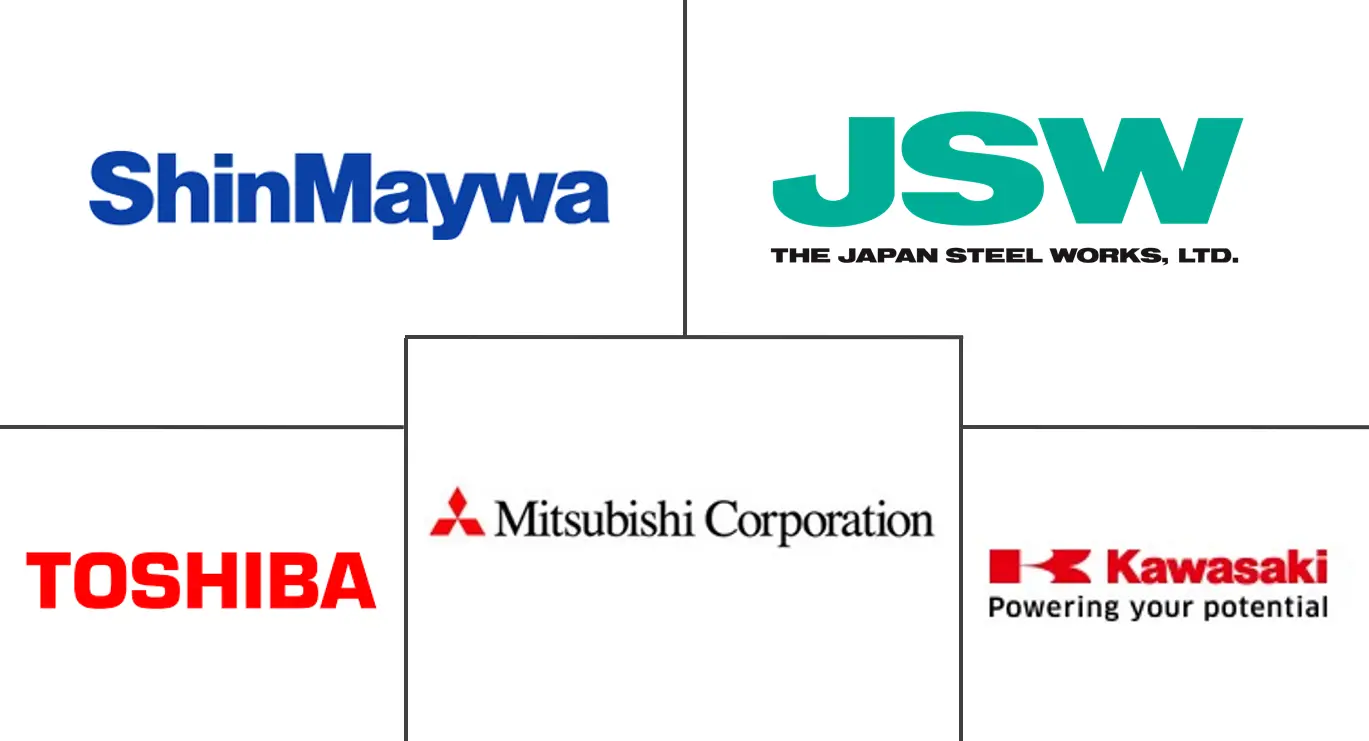
*Disclaimer: Major Players sorted in no particular order |
Japan Defense Market Analysis
The Japan Defense Market size is estimated at USD 48.10 billion in 2024, and is expected to reach USD 56.85 billion by 2029, growing at a CAGR of 3.40% during the forecast period (2024-2029).
- The security environment in Japan has become increasingly stressed, with several international challenges and destabilizing factors becoming more acute. Hence, to adapt to the growing changes in the security environment, Japan has been strengthening its defense capabilities at a rapid pace. According to the report published by the Stockholm International Peace Research Institute (SIPRI) in 2022, Japan was the tenth largest defense spender in the world, with a defense budget of USD 46 billion. The country approved USD 51.4 billion in defense spending in FY2023.
- Japan is modernizing its defense arsenal, which involves upgrades in air and maritime defense systems as well as investments in space and cyber capabilities. In order to realize cross-domain operations, the armed forces are planning to acquire and strengthen capabilities in new domains, including space, cyberspace, and the electromagnetic spectrum, by investing financial resources into the R&D of such systems, which is expected to drive market growth.
- The Japanese defense market faces several challenges that may act as restraints in the forecast decade. Geopolitical tensions in the Asia-Pacific region may pose some challenges, as Japan has delicate relationships with neighboring countries. Secondly, Japan's strict arms export policies may limit its defense industry's global sales. These policies could block the growth of the defense market by restricting international collaborations and sales.
- The Japanese defense market presents opportunities due to the evolving security landscape, marked by regional tensions, which creates a demand for advanced defense technologies. Manufacturers in Japan can capitalize on this by investing in research and development and promoting innovation in areas such as cybersecurity, unmanned systems, and artificial intelligence. Similarly, collaborations with international partners can open opportunities for technological advancements and joint ventures. Manufacturers can leverage global expertise by forming strategic alliances. Additionally, Japan’s initiatives to ease some restrictions on arms exports may unlock new markets for Japanese defense manufacturing companies.
Japan Defense Market Trends
The Air Force Segment Projected to Show the Highest Growth During the Forecast Period
- The Air Force segment is expected to experience the highest growth rate during the forecast period. The growth is attributed to the various ongoing procurement plans for replacing the aging combat aircraft and expanding the fighter jet fleet. Japan plans to acquire 42 F-35Bs and a total of 157 F-35s. Japan's Ministry of Defense plans to allocate over JPY 100 billion (about USD 905 million) in the FY2022 draft budget for the acquisition of about 10 additional F-35A and F-35B stealth fighter jets.
- The armed forces are focusing on enhancing capabilities in the air domain, with an enhanced focus on stand-off defense capability, comprehensive air, and missile defense capability, and deployment capability to effectively counter incoming threats. The country is also working on the development of the Mitsubishi F-X, a sixth-generation stealth fighter for the Japan Air Self-Defense Force. It is Japan's first domestically developed stealth fighter jet and will replace the Mitsubishi F-2 by the mid–the 2030s. Also, in January 2022, the US Department of Defense (DoD) announced a contract worth USD 471 million to The Boeing Company for the development of new systems for Japan Air Self-Defense Force's (JASDF) F-15 Eagle Super Interceptors fleet.
- The Japanese firms have also contributed to the development of various engineering test satellites, marine and terrestrial observation satellites, communications, broadcasting, global navigation satellites, etc., including weather satellites such as the HIMAWARI 8 and 9. In 2022, the Japanese government spent USD 550 million on space activities. The Japanese space firms developed launch vehicles such as the M-V, H-IIA/B, and Epsilon rockets. The Japanese satellite manufacturers are also using their advanced technical capabilities, high quality, and competitive costs to open the overseas market. Thus, growing expenditure on research and development and rising spending on enhancing aviation infrastructure drive market growth across the country.
- Furthermore, with the relaxation of Japan’s strict arms export regulations, the Japanese Ministry of Defense (MoD) entered an agreement with the British government to develop, design, and procure next-generation air-to-air missiles. Such developments are envisioned to contribute to the growth of the Air Force segment during the forecast period.
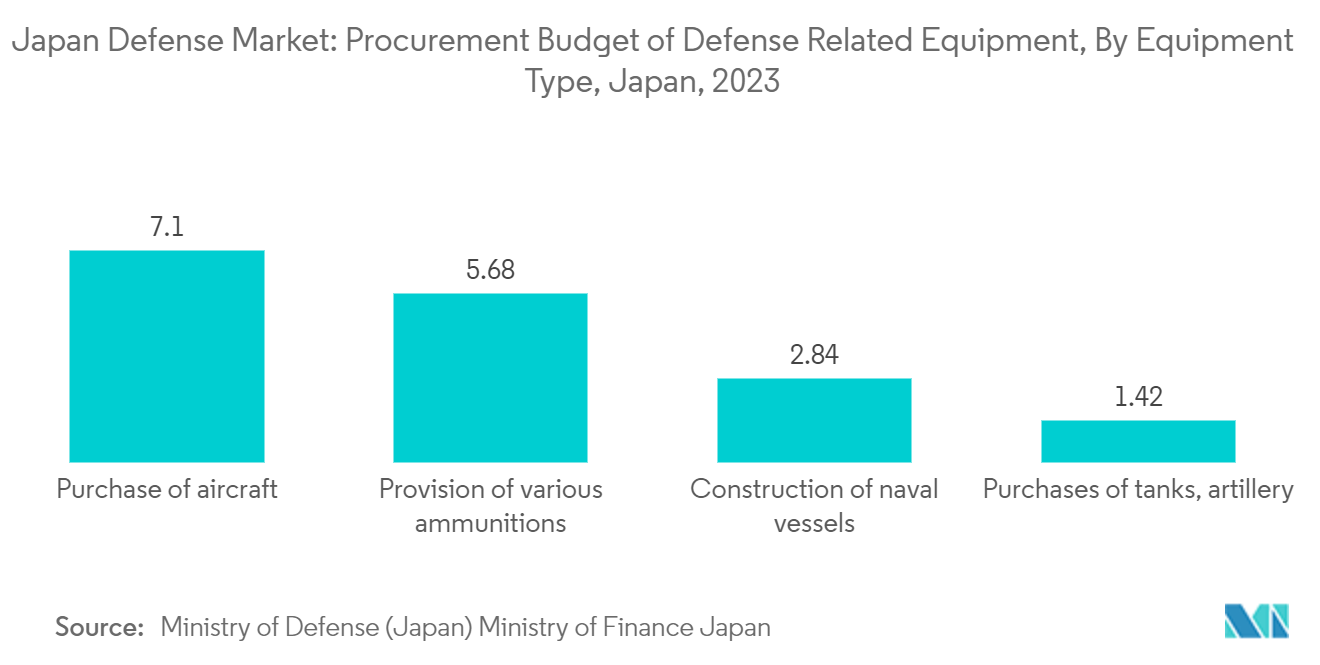
C4ISR and EW Type to Witness Significant Growth During the Forecast Period
- The increase in C4ISR investments reflects Japan's commitment to modernize its defense infrastructure. As threats evolve and become more sophisticated, the integration of advanced C4ISR systems becomes necessary for enhanced situational awareness, real-time data sharing, and streamlined decision-making processes within the armed forces. The Electronic Warfare Development Center, operating under the Technical Research and Development Institute (TRDI) of the Ministry of Defense, exemplifies Japan's active stance in developing state-of-the-art EW capabilities.
- Japan’s National Defense Program Guidelines (NDPGs) and the associated Mid-term Defense Plan (MTDP) have also put a strong emphasis on three new defense domains in the country, namely, cyber, space, and electronic warfare (EW). In 2021, the Japanese government approved about USD 590 million for space-related projects, which include projects procurement of Space Situational Awareness (SSA), Satellite (Space-based Optical Telescope), enhancing resiliency of satellite communication systems, and others.
- Similarly, the cyber-related budget was about USD 270 million, which includes the establishment of the Japan Self-Defense Force Cyber Defense Command and spending on projects like the procurement of a Cyber Information Gathering System and improvement of cyber protection analyzing devices and the defense information infrastructure.
- In the electromagnetic domain, the government is also planning to develop stand-off electronic warfare aircraft and a network electronic warfare system. In October 2022, Japan and Australia signed a new bilateral security agreement that covered military, intelligence, and cybersecurity cooperation to counter the deteriorating security outlook driven by China’s growing assertiveness.
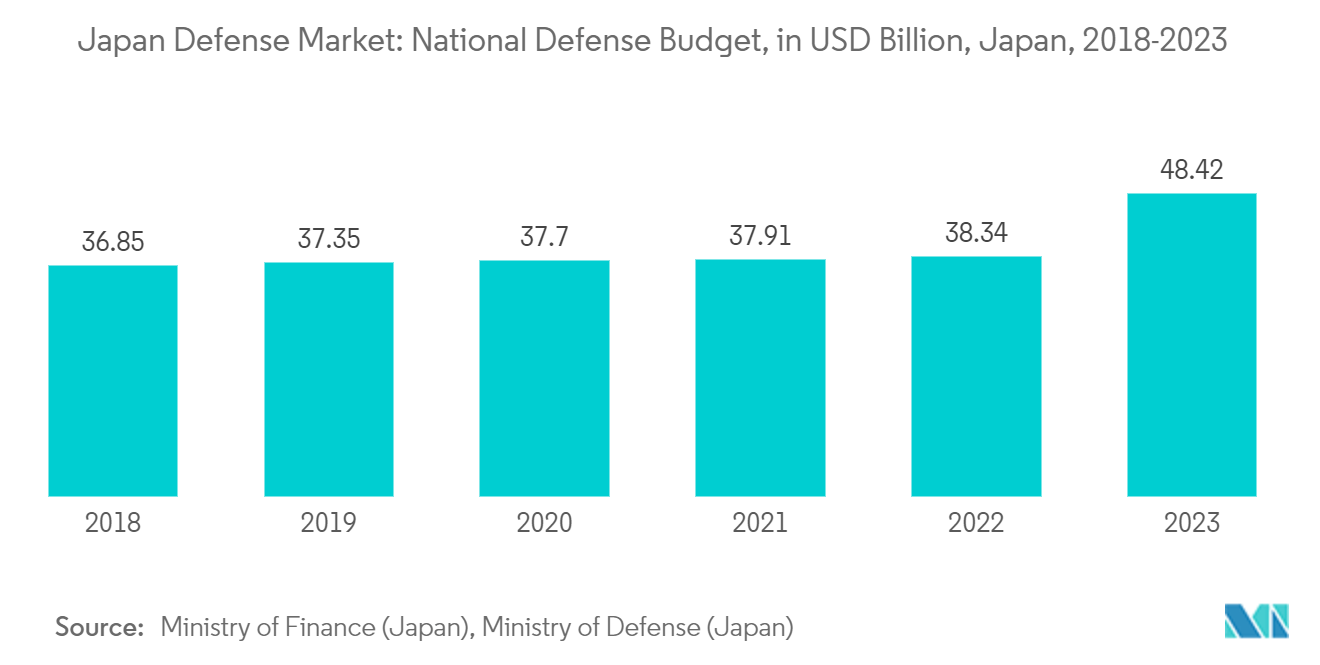
Japan Defense Industry Overview
The Japan defense market is semi-consolidated in nature, with the presence of a few prominent players in the market, including Kawasaki Heavy Industries, Ltd., Mitsubishi Heavy Industries, Ltd., ShinMaywa Industries, Ltd, Japan Steel Works Ltd, and Toshiba Corporation.
Despite a strong local manufacturing base, players in the country are currently facing stiff competition from their foreign counterparts for growing their businesses, especially from players from North America and Europe, even with a greater focus on local production and measures like the relaxation of Japan’s self-imposed arms export ban policy. In this regard, local defense giants are undertaking various initiatives and investing in the R&D of new defense systems to produce sophisticated products, thereby enhancing their competitiveness in the market.
Japan has adopted new principles and guidelines on arms exports and would permit arms exports to a country only if they serve the purpose of contributing to international cooperation and its security interests. According to the 2022 defense white paper, nearly 1,100 companies are involved in the manufacture of fighter aircraft, about 8,300 in building destroyers, and around 1,300 in the production of tanks.
Growing support for local aerospace and defense manufacturers and rising investment in research and development boost the market growth during the forecast period. For instance, the Japanese Ministry of Defense (MoD) secured USD 6.23 billion for ammunition-related spending, which is 330% higher than in 2022. It included USD 1.59 billion for the procurement of 500 US-made long-range Tomahawk cruise missiles. The Japanese MoD will deploy the Tomahawks in fiscal year 2026-27 as it aims to develop counterstrike capabilities. Tokyo will acquire the advanced model Tomahawk Block V to be equipped with Japan Maritime Self-Defense Force (JMSDF) Aegis-equipped destroyers.
Japan Defense Market Leaders
-
Kawasaki Heavy Industries, Ltd.
-
Mitsubishi Heavy Industries, Ltd.
-
ShinMaywa Industries, Ltd.
-
The Japan Steel Works, Ltd.
-
Toshiba Corporation
*Disclaimer: Major Players sorted in no particular order
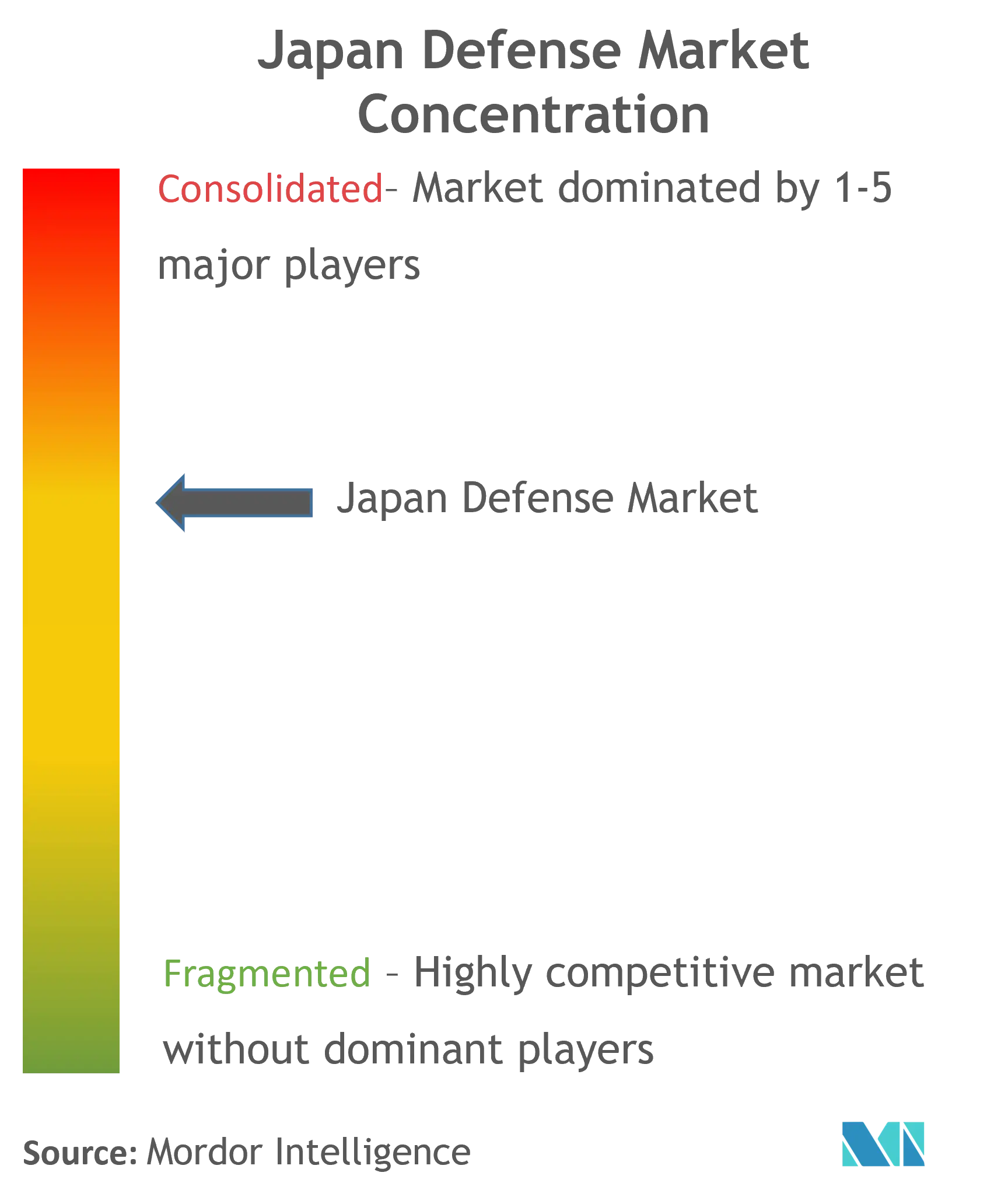
Japan Defense Market News
- April 2023: Japan's Defense Ministry signed a contract worth USD 3 billion with Mitsubishi Heavy Industries Ltd. to develop and mass-produce long-range missiles for deployment by 2026. The contracts include advanced versions of Mitsubishi's Type 12 missiles for surface, sea, and air launches, as well as a hypersonic ballistic missile for the defense of remote islands.
- May 2023: Japan and the UAE signed an agreement on defense equipment and technology transfers in a move that enables joint research, development, and production. The agreement comes as Japan started works on a next-generation fighter aircraft with the UK and Italy, which is likely to be marketed in these three countries and as well other countries, including Middle Eastern countries.
- October 2022: The US approved the sale of 32 Standard Missile 6 Block I missiles and MK 21 vertical launch systems to Japan. The value of the contract was USD 450 million. Under the proposed sale, RTX Corporation will provide training equipment, spares, engineering services, and logistics support services.
Japan Defense Market Report - Table of Contents
1. INTRODUCTION
- 1.1 Study Assumptions
- 1.2 Scope of the Study
2. RESEARCH METHODOLOGY
3. EXECUTIVE SUMMARY
4. MARKET DYNAMICS
- 4.1 Market Overview
- 4.2 Market Drivers
- 4.3 Market Restraints
5. MARKET SEGMENTATION
-
5.1 Armed Forces
- 5.1.1 Air Force
- 5.1.2 Army
- 5.1.3 Navy
-
5.2 Type
- 5.2.1 Personnel Training and Protection
- 5.2.2 C4ISR and EW
- 5.2.3 Vehicles
- 5.2.4 Weapons and Ammunition
6. COMPETITIVE LANDSCAPE
-
6.1 Company Profiles
- 6.1.1 Kawasaki Heavy Industries, Ltd.
- 6.1.2 Lockheed Martin Corporation
- 6.1.3 The Boeing Company
- 6.1.4 BAE Systems plc
- 6.1.5 RTX Corporation
- 6.1.6 Northrop Grumman Corporation
- 6.1.7 THALES
- 6.1.8 Mitsubishi Heavy Industries, Ltd.
- 6.1.9 ShinMaywa Industries Ltd.
- 6.1.10 The Japan Steel Works Ltd.
- 6.1.11 Toshiba Corporation
- 6.1.12 Subaru Corporation
- 6.1.13 Komatsu Ltd.
- *List Not Exhaustive
7. MARKET OPPORTUNITIES AND FUTURE TRENDS
** Subject To AvailablityJapan Defense Industry Segmentation
The study covers all aspects and provides insights into the budget allocation and spending in the Japanese defense market, along with the forecast estimates. The market includes details about the procurement and modernization plans of the Japan Self-Defense Forces including aircraft, land tactical vehicles, naval vessels, unmanned systems, and military equipment like weapon systems, missile defense systems, missiles, ammunition, etc. The market also includes details regarding investments in the research and development of advanced technologies like directed energy weapons, the use of composites, and advanced manufacturing technologies like 3D printing, among others.
The Japanese defense market is segmented by armed forces and type. By armed forces, the market is segmented into the Airforce, army, and navy. By type, the market is segmented into personal training and protection, C4ISR and EW, vehicles, and weapons and ammunition.
The market sizing and forecasts have been provided in value (USD).
| Armed Forces | Air Force |
| Army | |
| Navy | |
| Type | Personnel Training and Protection |
| C4ISR and EW | |
| Vehicles | |
| Weapons and Ammunition |
Japan Defense Market Research FAQs
How big is the Japan Defense Market?
The Japan Defense Market size is expected to reach USD 48.10 billion in 2024 and grow at a CAGR of 3.40% to reach USD 56.85 billion by 2029.
What is the current Japan Defense Market size?
In 2024, the Japan Defense Market size is expected to reach USD 48.10 billion.
Who are the key players in Japan Defense Market?
Kawasaki Heavy Industries, Ltd., Mitsubishi Heavy Industries, Ltd., ShinMaywa Industries, Ltd., The Japan Steel Works, Ltd. and Toshiba Corporation are the major companies operating in the Japan Defense Market.
What years does this Japan Defense Market cover, and what was the market size in 2023?
In 2023, the Japan Defense Market size was estimated at USD 46.46 billion. The report covers the Japan Defense Market historical market size for years: 2019, 2020, 2021, 2022 and 2023. The report also forecasts the Japan Defense Market size for years: 2024, 2025, 2026, 2027, 2028 and 2029.
Japan Defense Industry Report
Statistics for the 2024 Japan Defense market share, size and revenue growth rate, created by Mordor Intelligence™ Industry Reports. Japan Defense analysis includes a market forecast outlook to 2029 and historical overview. Get a sample of this industry analysis as a free report PDF download.



